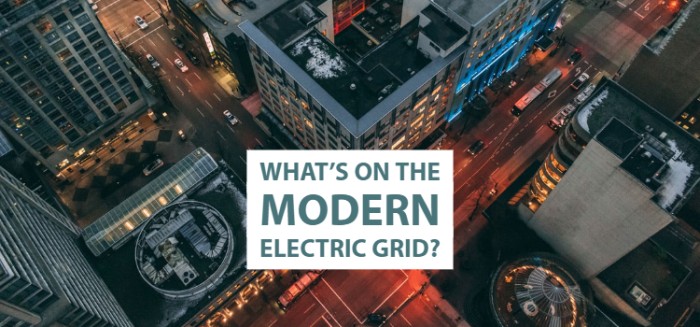What's On the Modern Electric Grid?
 | Isak Kvam, Communications / Policy Associate |

 | Isak Kvam, Communications / Policy Associate |
The U.S. electricity system is in the midst of a massive transition toward clean energy, as indicated by policies, economics, customer demand, and electric grid managers. In fact, wind and solar energy have surpassed 10.5 percent of the country’s installed generating capacity. And, the Lawrence Berkeley National Lab has found that wind and solar could provide 40 to 50 percent of our needs by 2030. By powering our economy with low-cost wind and solar energy, average wholesale power prices would drop $5-16/MWh — which is good for our economy and our families. So what does the future of our grid look like?
To understand the future of our electric grid, we first have to look at our traditional electric grid. We generate electricity at large, decentralized power plants and use transmission lines to transport those electrons to where that electricity is needed in our homes and businesses. Electricity grid managers must constantly balance just the right amount of energy to meet demand every few seconds and tell power plants to ramp up or down, accordingly.
To make sure that your lights turn on at the flick of a switch, the grid operator asks power plants to make more energy than we actually need. Just how much extra energy to we make? In 2017, 66 percent of the electricity the U.S. generated was wasted. That is a massive amount of energy we are paying not to use — especially since much of this comes from more costly fossil fuels that also affect our air and water quality. Upgrading our grid to be more efficient just plain makes good economic sense.
The grid of the future will use new, clean technologies to generate cheaper electricity that is reliable and resilient by using wind, solar, and new electric grid services like energy storage.
Wind energy is the cheapest source of new electricity in much of the U.S. after its cost plummeted over the course of this decade, and solar costs are dropping just as quickly. That’s why renewable energy makes up three-fourths of the Midwest’s new electric capacity added in the past five years. There’s a bonus to this new energy strategy, too. As we add more wind and solar, we simultaneously decarbonize our economy and pay less for these renewable resources. While this transition happens, our electric grid managers have been busy adapting and planning how to best harness cheap wind and solar. But they face certain challenges.
Wind and solar energy throw a curveball at how grid managers balance the grid. While grid operators have successfully managed more than sixty percent of wind power on the grid at once, they still face the challenge of deploying more renewables more often. Solar energy has its infamous duck curve challenge, where grid operators have to balance people’s electricity needs with when there is abundant, cheap solar energy. The Midwest has its alligator curve with all of its wind power. And there’s been plenty of discussion at the national level about improving the reliability and resilience of the electric grid. So how do grid managers adapt to these new challenges to make the grid more efficient?
There isn’t a single silver bullet for upgrading the grid, but you could classify the many new solutions as making the grid more flexible. That means updating our transmission lines, substations, and transformers with digital technology to use computers, automation, and software to make it more efficient. We will be using incentives and programs to use energy more wisely - like demand response, time-of-use rates, and more. It also means using new energy storage technology to store wind and solar when it’s made to be used later when we need it.
Batteries don’t just store energy - they provide a myriad of new benefits to make the grid more reliable and resilient. They offer services like voltage support and frequency regulation. They reduce grid congestion, balance short-term power, manage peak demand, act as a backup and prevent power outages, and avoid new infrastructure investments. Like Kelly Speakes-Backman of the Energy Storage Association says, energy storage is like the bacon of the electric grid — it just makes everything better. Even though energy storage doesn’t produce any energy, it makes renewable energy even more economically efficient and helps the grid become even more stable and flexible.
Subscribe to our newsletter for the latest on energy & our work
In a time when building new natural gas plants is increasingly risky while wind-plus-storage and solar-plus-storage are setting record-low prices, this transition is already playing out faster than anyone anticipated. In fact, there is now a record 38 GW of wind energy under construction in the U.S. And while only one GW of energy storage has been installed in the U.S., more than 35 GW are expected by 2025.
The U.S. electric grid is the largest interconnected machine on earth and was named the “supreme engineering achievement of the 20th century” by the National Academy of Engineers. It powers every aspect of our lives, from our workspaces and homes, our phones and computers, and increasingly, our vehicles. With American ingenuity, innovation, hard work, and a little luck, the new grid will become the greatest achievement of the 21st century.
This post originally appeared in Morning Consult.